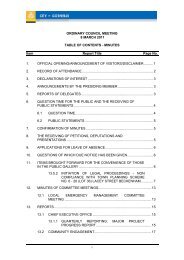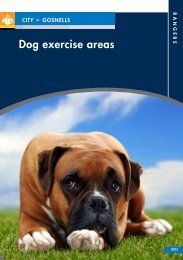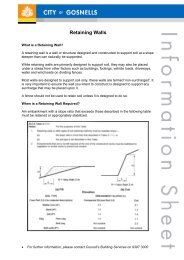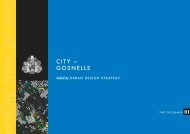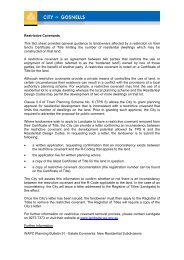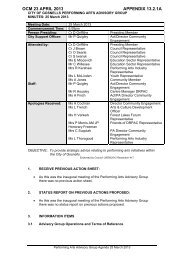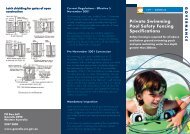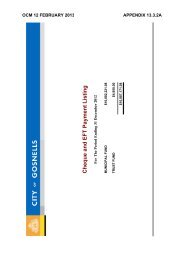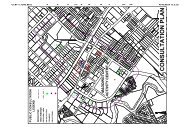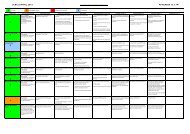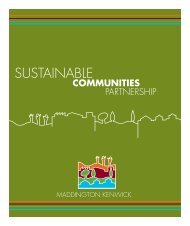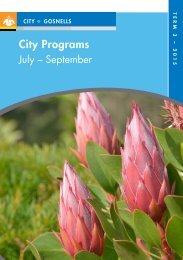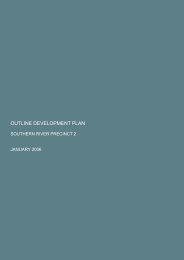Wetlands Field Survey 776. Wetlands Field SurveyThe current wetlands survey built on the foundation provided by the mapping <strong>of</strong> Hill et al. (1996). It enabledthe recognition <strong>of</strong> additional wetlands, geomorphic wetland types and wetland values that were notpreviously known in the area. It also provided a fine scale management category assessment for all <strong>of</strong> thewetlands that are mapped as CCW and or REW in DEC (2008a). To complete the wetland assessmentrequired by DEC (2007) for recommendations to amend or modify the SCP Wetlands Dataset, further studyis indicated to delineate wetland boundaries more accurately and characterise factors (such as MucheaLimestone aquifers) that maintain wetlands, particularly along the interfaces <strong>of</strong> the Pinjarra Plain with theBassendean Dunes. As there are complex stratigraphic/hydrological features and threatened ecosystems inthe area, this study should be carried out by specialist wetland scientists with ecological expertise. It shouldalso be at a fine scale that is appropriate to the processes that affect native vegetation and part <strong>of</strong> an overallplan for determining and restoring the environmental water requirements <strong>of</strong> the vegetation <strong>of</strong> the greater area<strong>of</strong> the alluvial fan and increasing the quality and quantity <strong>of</strong> the groundwater in the Yule Brook and BickleyBrook catchments.The MKSEA is part <strong>of</strong> an alluvial fan complex that forms an almost continuous wetland ecosystem thatextends over most <strong>of</strong> Kenwick and Maddington and has been mapped as about 70 wetlands (palusplains,sumplands or damplands) that are identified under Unique Function Identifiers (UFIs) in the SCP WetlandsDataset (DEC, 2008a; Table 6.1). Other wetland types (palusplains and floodplains) that are rarer on the SCPhave also been described at a finer scale in the vicinity <strong>of</strong> the MKSEA (VCSRG, 2001). The system fornumbering individual wetlands using UFIs in DEC (2008a); Figures 9, 10; Table 6.1) is somewhat artificialin the MKSEA (and other areas <strong>of</strong> the Pinjarra Plain) as the boundaries <strong>of</strong> wetlands are not clearly evident inlow relief, predominantly wetland landscapes that are underlain by complex stratigraphy. UFI boundaries insuch areas are largely artefacts <strong>of</strong> the various land uses and cadastral boundaries, whereas the natural wetlandboundaries are, usually, the interfaces between the wetland landscape <strong>of</strong> the Pinjarra Plain and any uplandareas <strong>of</strong> low dunes <strong>of</strong> Bassendean Sands.From the broadscale mapping <strong>of</strong> surface sediments and landforms in Kenwick and Maddington (Jordan,1986; Figure 6) and the climate <strong>of</strong> the SCP, it could be predicted that the only parts <strong>of</strong> the MKSEA area thatare not waterlogged or inundated in winter would be relatively small areas <strong>of</strong> dunes. In the project area, suchuplands all occur in the broadscale soil type S8 (Figures 6, 11) where deep Bassendean Sands overlie themuddy sediments <strong>of</strong> the Guildford Formation. Under the Mediterranean climate that is experienced by<strong>Gosnells</strong> (with a mean rainfall <strong>of</strong> approximately 838 mm per annum) most <strong>of</strong> the flat or gently undulatinglands <strong>of</strong> shallow Bassendean Sands over the Guildford Formation (S10), the clayey sands (Sc) and the sandyclays (Cs) <strong>of</strong> the MKSEA could be expected to be poorly drained. Given appropriate topography, these areason the eastern SCP readily form palusplains (seasonally waterlogged flats), sumplands (seasonally inundatedbasins) or damplands (seasonally waterlogged basins), due to the perching <strong>of</strong> rainwater by shallow aquitards.To database the plethora <strong>of</strong> wetlands on the SCP, DEC (2008b) has allotted a Unique Function Identifier(UFI) to each wetland. This number usually applies to the full natural extent <strong>of</strong> the wetland irrespective <strong>of</strong>cadastral boundaries. An exception to this rule (that applies in the MKSEA) concerns the more extensivewetlands in the dataset (those with an area greater than 70 ha) that are not lakes or sumplands and have beendegraded over part <strong>of</strong> their extent. These are divided into several sections (according to wetland condition)and have a separate UFI for each section. In the MKSEA, although the wetlands in DEC (2008b) are mappedunder a total <strong>of</strong> about 70 UFI numbers, this large number <strong>of</strong> wetlands is mainly a consequence <strong>of</strong> the patchyland use history <strong>of</strong> this area (and subsequent wetland degradation) and not the natural wetland boundaries. Inthis ecosystem, the individual wetland areas that are mapped under separate UFIs are generallyinterconnected by such factors as groundwater flow, subsurface water flows along impermeable layers andchannelled surface water flows (Perth Groundwater Atlas, 2004; VCSRG, 2001).The natural wetland boundaries <strong>of</strong> the MKSEA (including the main boundaries between the wetlandlandscape <strong>of</strong> the Pinjarra Plain and the small upland area <strong>of</strong> the Bassendean Dunes) particularly in the areasthat have been cleared <strong>of</strong> native vegetation, are not sharply marked and are difficult to delineate withoutdetailed hydrogeological studies. This was illustrated in BFS 387, where the wetlands were investigated byVCSRG (2001) using the same principles that they had developed in Hill et al. (1996), but at a finer scale.Tauss, C. and Weston, A.S. (2010). The flora, vegetation and wetlands <strong>of</strong> the Maddington-Kenwick Strategic Employment Area.A survey <strong>of</strong> the rural lands in the vicinity <strong>of</strong> the Greater Brixton Street Wetlands. Report to the <strong>City</strong> <strong>of</strong> <strong>Gosnells</strong>, W.A. Version 18.04.10
Wetlands Field Survey 78The stratigraphic sequences (that underlie the superficial sediments that were mapped simply by Jordan in1986 as S10, Cs and Sc) were found to be complex and varied. Also many factors (groundwater, artesianflow, subsurface seepage etc) apart from rainfall were found to contribute to the recharge and discharge <strong>of</strong>wetlands in this area (VCSRG, 2001). Thus in some areas <strong>of</strong> the dunes, (e.g. in the University <strong>of</strong> WesternAustralia Allison Baird Flora Reserve), the seasonal waterlogging was found to extend over part <strong>of</strong> theslopes <strong>of</strong> dunes and to form paluslopes (seasonally waterlogged slopes). Floodplains (seasonally inundatedflats) were also found to be present adjacent to the dunes. The paluslopes and floodplains described in BFS387 in VCSRG (2001) have not, as yet, been incorporated into the SCP Wetland Dataset. Paluslope wetlandsare uncommon in south west Western Australia. Paluslopes have not been characterised in any other areas <strong>of</strong>the SCP. Floodplains with intact native vegetation are also very uncommon on the SCP as most <strong>of</strong> thesewetlands have been cleared for agriculture or highly modified by drainage works. Both paluslopes andfloodplains are represented by areas <strong>of</strong> intact native vegetation in BFS 387; these wetlands are <strong>of</strong> highconservation significance.The primary task <strong>of</strong> the current survey was to characterise the conservation values in the MKSEA. As intactnative vegetation is usually a good proxy for high conservation values on the eastern SCP, the current surveyfocussed primarily on all <strong>of</strong> the areas <strong>of</strong> remnant native vegetation in the MKSEA that could be classed as‘native bushland’ according to Government <strong>of</strong> Western Australia (2000). Each area <strong>of</strong> native bushland wasexamined in the reconnaissance survey and most were later sampled in the site-based flora and vegetationstudy. Many <strong>of</strong> the sampled sites were also investigated with regard to stratigraphy and hydrology to verifywetland status in the manner recommended by DEC (2007). This approach captured all <strong>of</strong> the highconservation value wetlands in the MKSEA that are currently assessed as CCW and or REW (DEC, 2008). Italso enabled the recognition <strong>of</strong> some additional wetlands, some wetland types and wetland processes in theMKSEA that are <strong>of</strong> high conservation value and that were not previously known from Government <strong>of</strong>Western Australia (2000) or the SCP Wetlands Dataset (DEC, 2008).The current survey was not intended as a fine scale mapping <strong>of</strong> the wetland boundaries and a definitiveassessment <strong>of</strong> the management categories <strong>of</strong> wetlands (in order to submit a case for changes to the SCPWetlands Dataset DEC or to develop a plan to manage the important wetlands <strong>of</strong> the area for conservation)but as an overview that reliably identified areas <strong>of</strong> the highest conservation significance/ecologicalsensitivity and priorities for further investigation. Similarly, the water monitoring currently commissionedby the <strong>City</strong> <strong>of</strong> <strong>Gosnells</strong> (where the sampling <strong>of</strong> water levels has been confined to a small number <strong>of</strong>piezometers spread over a large area) will not be sufficiently intensive to adequately characterise thewetlands <strong>of</strong> the area to the standard required prior to rezoning and development proposals according to DEC(2007). Due to the complicated stratigraphy, hydrology and biology <strong>of</strong> the area, further fine-scale wetlandstudies at a scale and intensity similar to VCSRG (2001) should be carried out to map the main wetlandboundaries more accurately and to investigate and analyse the processes that maintain the wetlands. Thisadditional wetland mapping and assessment should be carried out at a scale that will take into account theeffect <strong>of</strong> the drainage measures that are installed on individual landholding blocks in the MKSEA. Implicit insuch a study would be an examination <strong>of</strong> the stratigraphy and hydrology at a scale appropriate to habitatvariables that determine native vegetation. It would be most appropriate to carry out such further wetlandswork as part <strong>of</strong> the development <strong>of</strong> an integrated management plan for remediating the hydrological cycle inthe area and the sustainable management <strong>of</strong> the water resources <strong>of</strong> Yule Brook, BFS 387, BFS 53 and areas<strong>of</strong> high conservation significance in the MKSEA.The wetlands identified and delineated in the current survey, the geomorphic classification and themanagement category determined for each wetland are presented below in Sections 6.1, 6.2 and 6.3respectively.Tauss, C. and Weston, A.S. (2010). The flora, vegetation and wetlands <strong>of</strong> the Maddington-Kenwick Strategic Employment Area.A survey <strong>of</strong> the rural lands in the vicinity <strong>of</strong> the Greater Brixton Street Wetlands. Report to the <strong>City</strong> <strong>of</strong> <strong>Gosnells</strong>, W.A. Version 18.04.10



